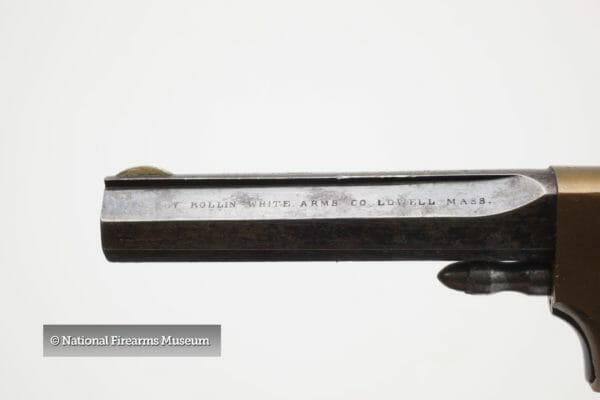
Williamstown, VT. – -(Ammoland.com)- On June 6, 1817, Rollin White was born in Williamstown, Vermont. Trained as a gunsmith by his brothers, Rollin would become best-known as the man who provided Sam Colt with a golden opportunity to be on the cutting edge of revolver design and was rebuffed.
One of the most important design breakthroughs in terms of handgun development was the bored-through cylinder. In 1849, while working for Colt, Rollin White took parts from condemned guns and began experimenting with their cylinder design. Patented in April 1855, White’s new design allowed self-contained metallic cartridges to be inserted and extracted with ease from the rear of the cylinder.

Rollin offered his patent to Sam Colt, which would have allowed him the exclusive right to make cartridge revolvers for more than a decade until the patent expired in 1869. White’s design was quite the departure, both in terms of arms and ammunition, from Colt’s bread-and-butter: cap-and-ball revolvers that reigned supreme and had made him quite the rich man. Basically, Colt had a “if it ain’t broke, don’t fix it” philosophy toward White’s idea and he passed on it.
White left Colt within a year and licensed his patent to Smith & Wesson. They came to an agreement that paid White $497 up front (almost $15,000 today) and 25 cents (almost $7 today) for each revolver they sold using his design. With the country soon involved in a civil war and seeing that there would be an increased need for arms, White opened “Rollin White Arms Company” about 100 miles from Smith & Wesson. There, he made revolvers under his patent and sold most of them to S&W to keep up with demand. By 1864, he had sold the business to Lowell Arms Company. They began making unlicensed guns using his design, which infringed on his patent, and he sued them.
This began a long process of litigation between White and S&W that involved lawsuits against a large number of small gun manufacturers. Most of the time, White and S&W won the cases. Sometimes the offending company was forced to pay royalties; other times, they were bought out and the guns were re-marked with White’s patent info before being sold.
One of the key pieces of brilliance on Smith & Wesson’s part in their royalty agreement with Rollin White was that he was responsible for paying his own court costs when it came to defending the patent. Even though S&W was paying White for each revolver they made, most of his royalties were tied up in court fees because of the widespread infringement on his patent.


When White was denied a patent extension in 1870, he decided to petition Congress on the grounds that he hadn’t been fairly compensated by S&W under the agreement he signed. It is estimated that S&W had made the modern equivalent of $17.5M from White’s design and that they had only paid him the modern equivalent of $1.2M in royalties.
White’s petition passed in both houses of Congress, but was vetoed by President (and former Civil War general) Ulysses S. Grant. One of the reasons he cited was from Chief of Ordnance Alexander Dyer, who called White’s patent an “inconvenience and embarrassment” to the military because it prevented manufacturers from creating revolvers with his innovative design during a time of war.
Even though Rollin White had a great design that we still use today in revolvers, his bad business deal with Smith & Wesson led to his financial ruin. He gave up on recouping his losses through Congress in 1877 and he died in 1892.
About Logan Metesh
Logan Metesh is a historian with a focus on firearms history and development. He runs High Caliber History LLC and has more than a decade of experience working for the Smithsonian Institution, the National Park Service, and the NRA Museums. His ability to present history and research in an engaging manner has made him a sought after consultant, writer, and museum professional. The ease with which he can recall obscure historical facts and figures makes him very good at Jeopardy!, but exceptionally bad at geometry.


Interesting………and now we know the rest of the story!